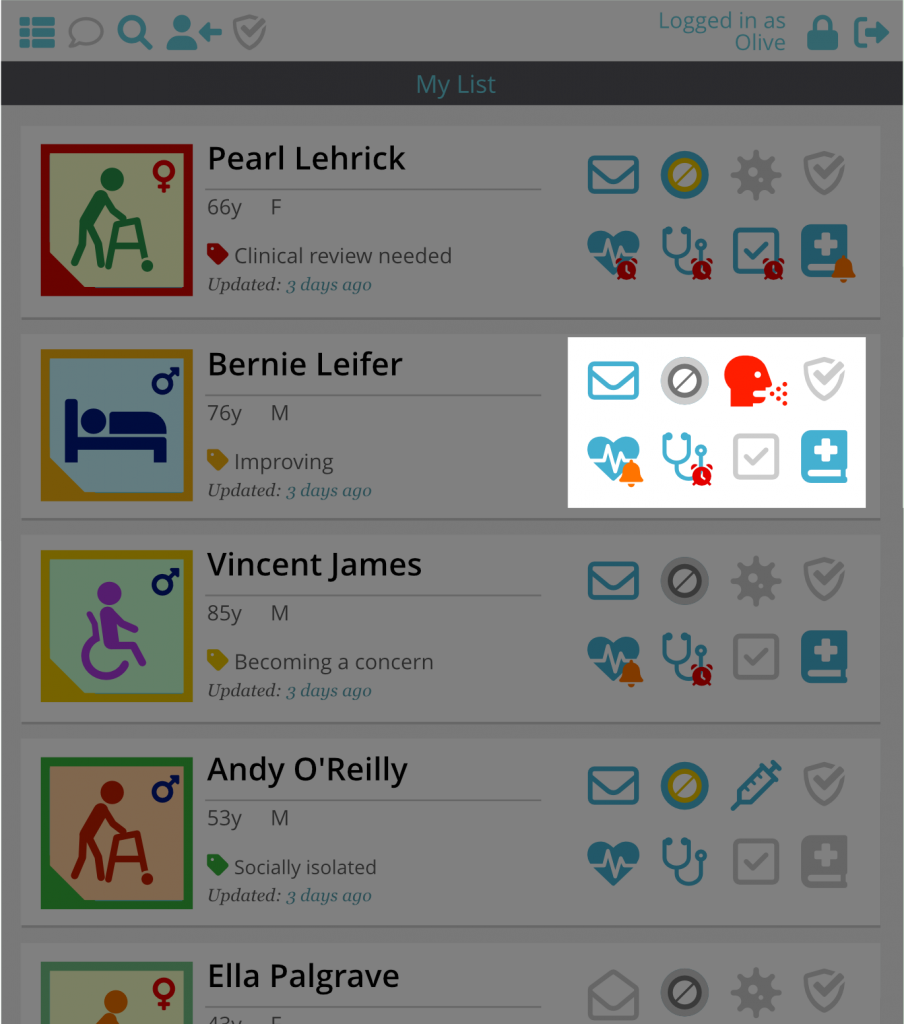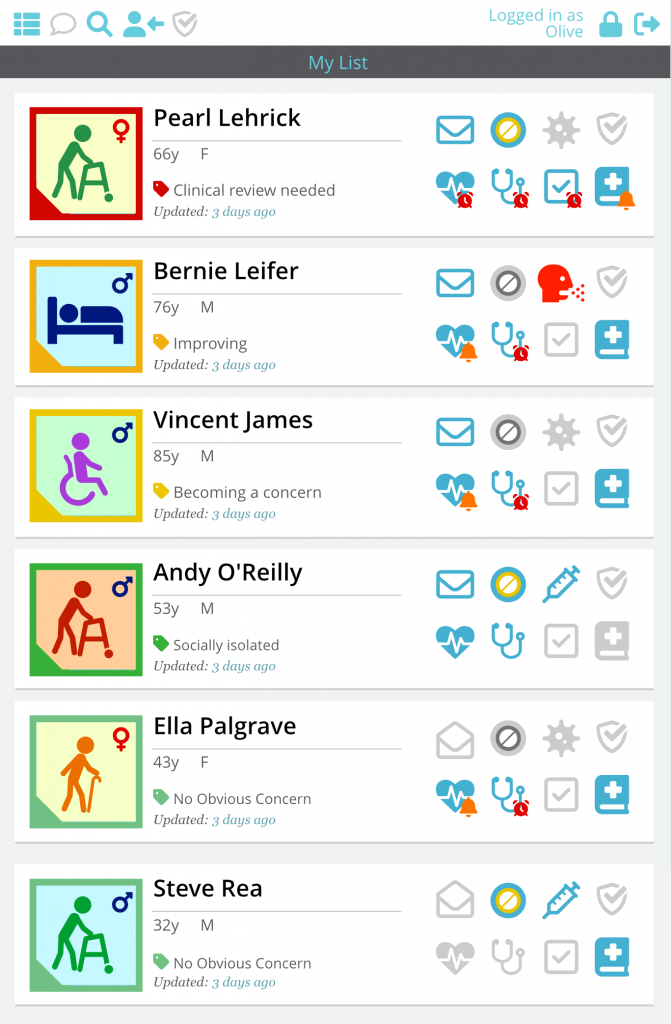
Welcome to the CHAI Hospice user guide.
Click on the contents list on the left to go directly to the area you need help with.
Alternatively, you can jump straight to finding out how to get started below.
Getting Started
Step 1: Look at My List of Patients
The first page you reach after logging into CHAI is “My List” of people that you will be helping, they will be referred to as Patients.
You can always return to this page by tapping on the List Icon inside the Header at the very top left of the screen.
If the individual you’re looking for is not in your list speak to your group manager or your team manager.
Tap anywhere on an patient’s banner to open up their Summary Page. Click here to jump to details about the Summary Page
The Header
The white bar across the top of the screen and its icons are referred to as the app’s Header
The icons here are global navigation buttons that persist across all pages.

These links include:
My List :
Return to your list of patients/ Group Chat :
Group messaging with your colleagues- Search for a specific patient
- Import a patient from an external source. This feature may be disabled depending on your version of CHAI.
Batch-Countersigning :
This feature allows full users to countersign entries completed by trainees. Depending on your version of CHAI, this feature may be disabled.- Assigned Tasks: This features enables you to view all the open tasks that are assigned to you.
Account & Password Management
Log Out
A Patient’s Banner within the List

Each patient that has been assigned to your team will be represented by a banner in your list, it provides a condensed view of their personal details and the status of their tasks.
Tapping anywhere on their banner will take you to the person’s Summary Page
On the far left, you will see their Personal Icon , a stick-figure that reflects their frailty which was assessed in the “patient details” section of the Admissions form. The border indicates the most recent wellbeing status, see below for a more detailed break-down.
The textual information gives you:
- Their Name
- (Their Preferred Name)
- Age and Gender
- Wellbeing Status Tag to match the Personal Icon’s border
- The last time their information was updated
A Patient’s Personal Icon and what it means

The stick person represents the individual’s frailty as assessed in the personal details form. There is a different stick person for each of the frailty scores.
The client’s sex is represented by
the Female Symbol or the Male Symbol . If a patient does not identify as either these or would prefer not to supply this information, the “other” radio button is available in the Patient Details form, there is an input box to further specify any details if desired. In this case, no gender icon will be shown.
The Personal Icon’s border changes colour based on the general wellbeing assessment. Any time you see this Personal Icon in the app, you can always tap on it to return to the patient’s Summary Page .
Frailty
Click here to see the full description of what each icon represents.
1.  Very Fit
Very Fit
2.  Well
Well
3.  Managing Well
Managing Well
4.  Vulerable
Vulerable
5.  Mildly Frail
Mildly Frail
6.  Moderately Frail
Moderately Frail
7.  Severely Frail
Severely Frail
8.  Very Severely Frail
Very Severely Frail
9.  Terminally Ill
Terminally Ill
Wellbeing Colour Code
The coloured border around the Personal Icon indicates the person’s wellbeing status that was last entered in the Contact Log . This uses a traffic-light colour scheme to indicate at-a-glance how they’re doing, where pale green is the most positive state, and a dark red border is reserved for the most serious concern.
In addition to the coloured border, their wellbeing is also indicated in the text that is displayed alongside the matching tag in the banner.
1. No obvious concern
Physically & mentally okay.2. No obvious concern but socially isolated
Consider signposting local support.3. Becoming a concern
Socially isolated.4. A concern but improving
Possibly as a result of professional help.5. Clinical review needed
Ensure professional services engaged.
Status & Shortcut Icons
These are visual warnings for tasks that need to be completed.
In general, they are grey if they are up to date and don’t need attention. They will turn blue if they contain tasks that are due at some point and require attention.
An orange bell attached to a status icon indicates that one of these forms is nearly due.
A red alarm clock attached to a status icon indicates that one of these forms is overdue.
From the full patient list, tapping on these will just take you to the person’s Summary Page , but if you are using any page that is associated with a specific person, tapping on one of these shortcut icons will take you directly to the relevant form.

The statuses included are:
Active Icons
| Unread Patient Notes Shortcut |  Person with Allergies Shortcut Person with Allergies Shortcut | Household Covid Status Indicator & Shortcut – see the full set of active icons here » | Countersigning Shortcut |
| Contact Log Shortcut | Assessment Tools Shortcut | Tasks are due | Care Plan due |
Inactive Icons
Icons become greyed out when forms are up to date and don’t require attention. Clicking on them will still you through to the relevant form.
| Read Patient Notes Shortcut |  Person with No Allergies Shortcut Person with No Allergies Shortcut | No Household Covid Status Information & Shortcut – see the full set of active icons here » | No Countersigning Shortcut |
| Contact Log is up to date | Assessment Tools are up to date | No tasks are due | No Care Plans are due |
Visit the Shortcuts & Status section of the Icons page to see the full details about what each icon indicates.
Step 2: See a Patient’s Summary Details

You can think of the Summary Page as a person’s home page, it can be reached by pressing the patient’s Personal Icon in the banner.
You can always return to the Summary Page at any time by tapping on the Personal Icon.
See the “what does a Personal Icon mean?” section to understand more.
All items on the Summary Page are interactive, such as the Patient Banner that appears accross the top.
The Summary Page contains the following:
Universal Banner Across the top of all of the pages that belong to a Patient
Each person will have a handy Banner that appears across the top of all of their pages. It’s a lot like the Banner shown in My List, but it has a number of enhanced features.
It provides a condensed view of person’s details and the status of their tasks as well as Shortcuts that can take you directly to relevant pages.
On the far left, you will see their Personal Icon .

The textual information gives you:
- Their Name
- (Their Preferred Name)
- Age and Gender
- Wellbeing Status , with colour tag to match the Personal Icon border
- Preferred Language
- Household Covid Status
- The reason why they are in need of support
- The last time their information was updated, and who made those changes
On the right, is the block of Status Icons , which also act as quick shortcuts to the relevant pages when you tap on them.
Side Menu Left hand side of the Summary Page
The side menu contains Icons and associated descriptions. Many of them are also in the Shortcut Icons in the Banner. It is simply down to personal preference which icons you use to get to the same place.
An orange bell attached to a menu item indicates that one of these forms is nearly due.
An orange bell attached to a status icon indicates that one of these forms is nearly due.
A red alarm clock attached to a status icon indicates that one of these forms is overdue.
See the menu section of the icon page for full details about what these icons mean.
- Admissions
- Discharge
- Contact Log
- Assessment Tools
- Care Plans
- Covid-19
- Forms & PDFs
- Concern or Help

Important Information Directly beneath the Banner on a Patient’s Summary Page
Provides an overview of key information including allergies and medical conditions (essential to know before food shopping).
Clicking any of the individual items in the list of Important Information will take you to the original Form where the data can be amended if necessary.

Patient Notes Write notes & tasks regarding this person
You can enter patient notes, attach files, photos, record audio or set tasks. Some notes / tasks are generated by the system automatically.
You can Filter the Patient Notes by task or simply tap on the Task icon in the Banner to see all open Tasks.
It is good practice to make regular notes about a person, especially if raising concern or noting consent.
Note: Remember they can be seen by all of your colleagues in your team and your name will be logged with the note or task.
If you have a general message for your team, rather than a note about a specific individual, then use the Group Chat at the top of every page.

Step 3: Completing the Admissions Form

Whilst you’re on the Person’s Summary Page look at their Side Menu . Tap on the link to Admissions to be taken to the Admissions form. The Form is split into different sections(cards). You can navigate through these using the quick link icon row below the patient banner or using ‘next’ and prev’.
After you enter information ALWAYS remember to press ‘SUBMIT’ at the bottom of the form for your information to be saved.
Section (cards) that you were the last person to enter information on and submit will show the card header in green. If another person was the last person to submit information the header will show in blue. A trainee will show as purple and an external system e.g information direct from a PAS will show as yellow.
Step 4: Assessment Tools and Care Plans
Assessment tools and Care Plans can be accessed by clicking the icons in the side menu or the Universal Banner. Each contain a number of Assessment Tools and Care Plans which can be selected to be used. The Contact Log can be accessed directly via can be the shortcut icon. Remember to hit ‘SUBMIT’ to save your entries. You can view previous entries by clicking on ‘History’ at the top right of each form.

